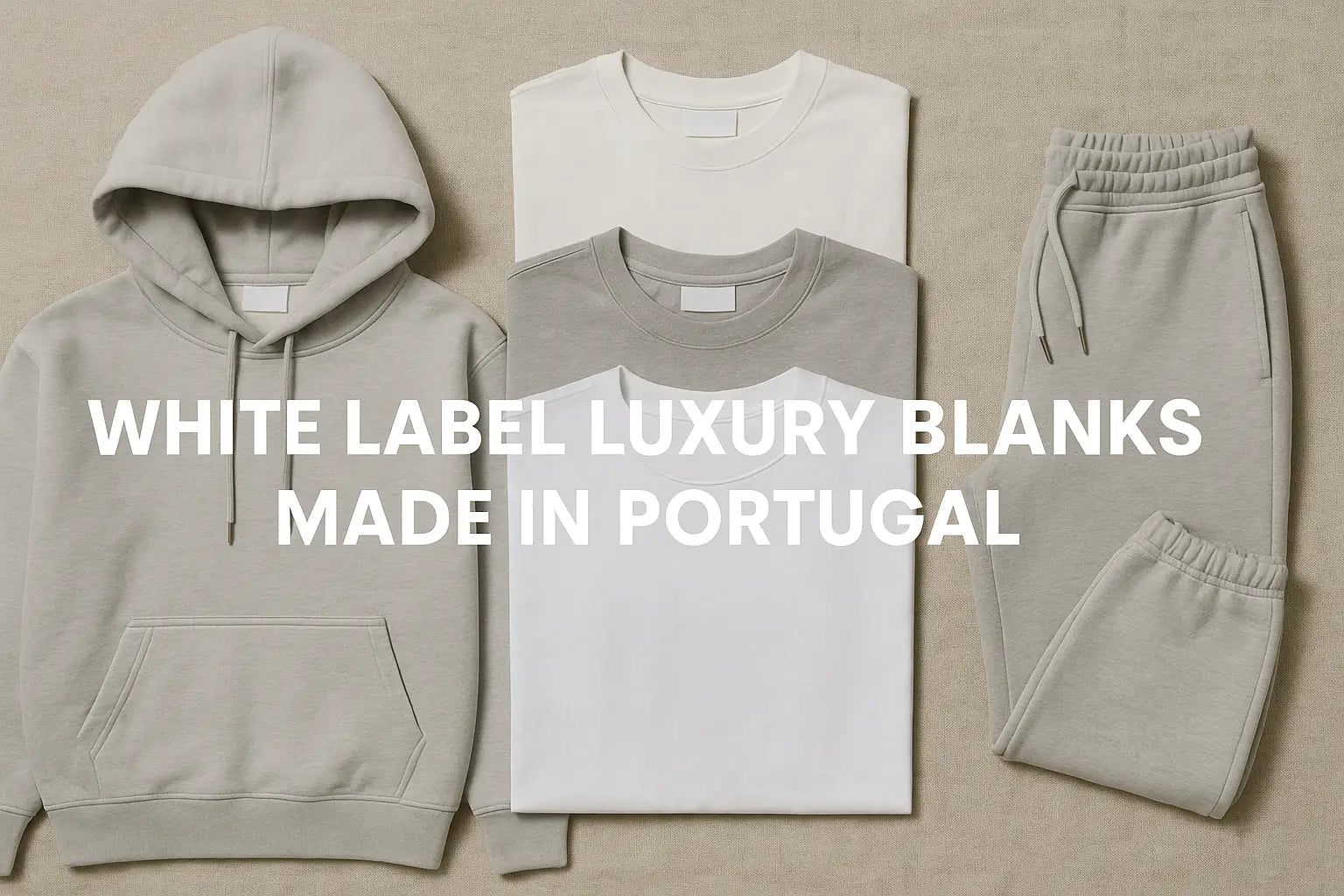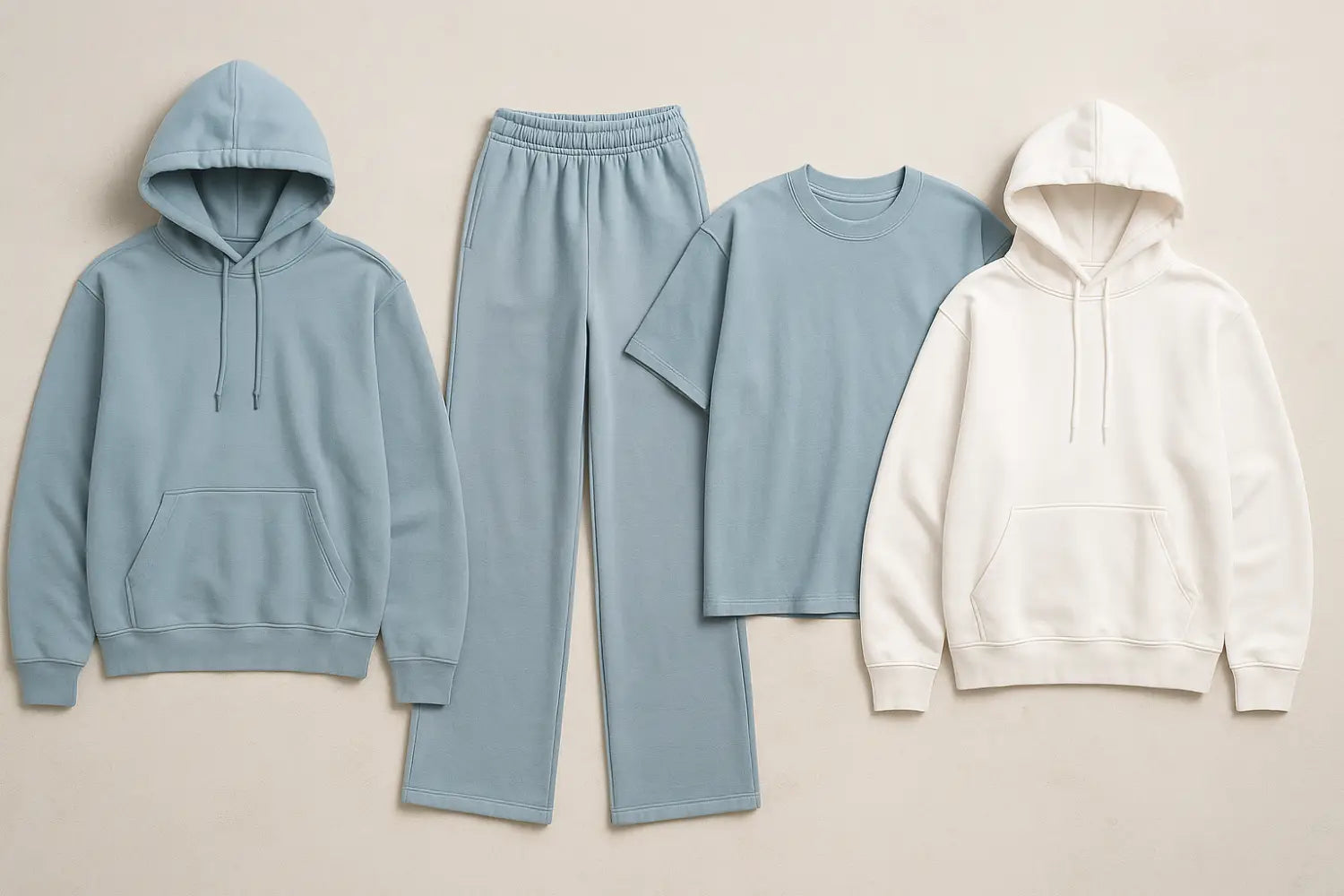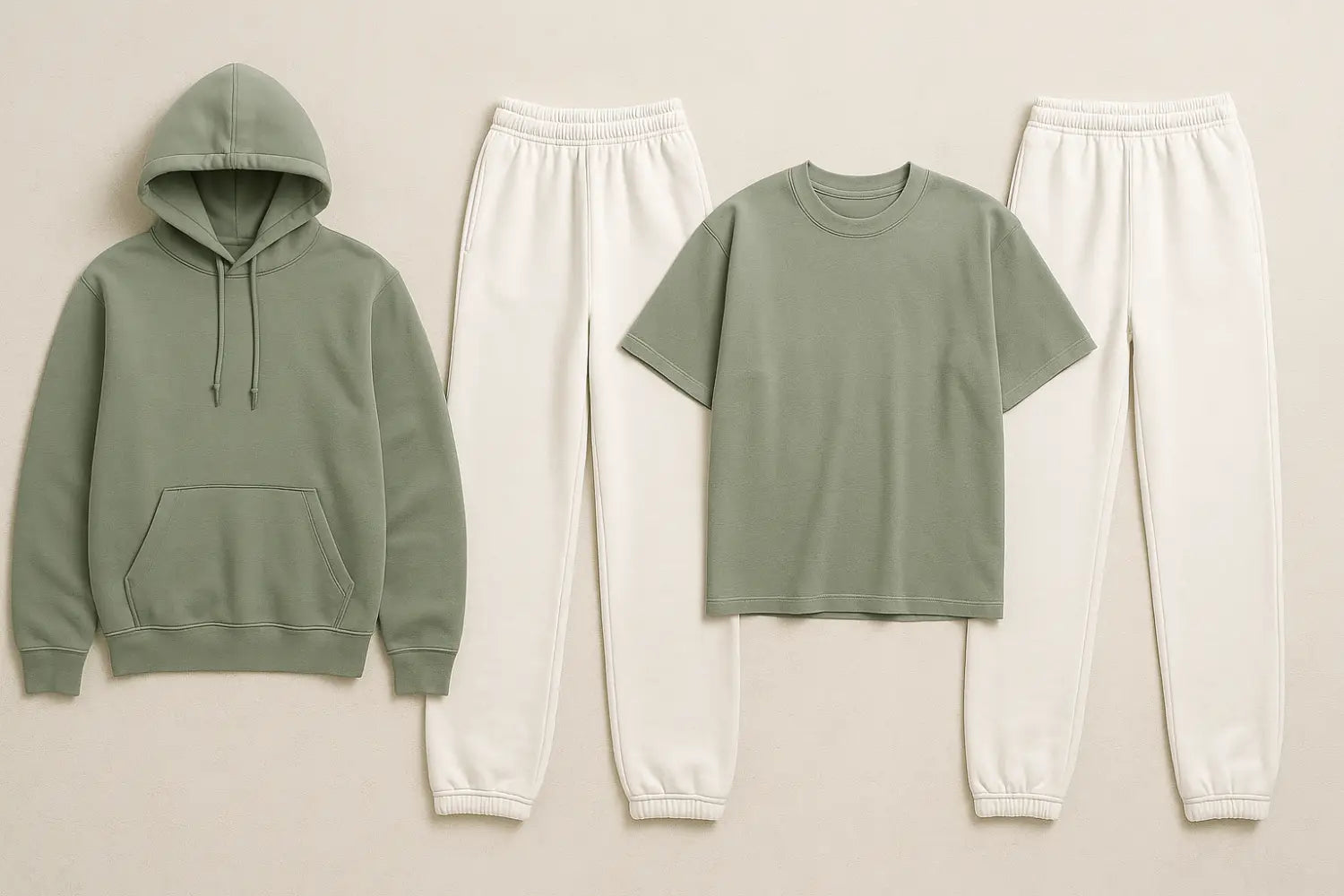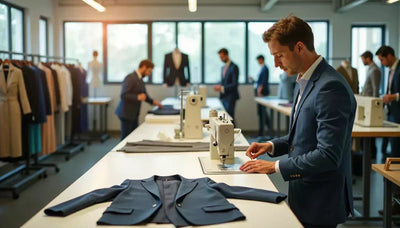
White Label Luxury Blanks: Heavyweight Hoodies, Oversized T-Shirts, and Activewear
The Ultimate Guide to White Label Luxury Blanks in Portugal: Heavyweight Hoodies, Oversized T-Shirts & High-Performance Activewear
Launch quickly with White Label Luxury Blanks. Graduate to custom once you validate demand.
Focus on oversized t-shirts, heavyweight hoodies, and activewear blanks. Portugal offers low MOQs, premium quality, and sustainable production.
Use our guides on GSM & fabric selection, printing, and dyeing to build products customers love. When ready, get a quote.
What Are White Label and Luxury Blanks?
White label, explained
White label garments are ready-made “blanks” produced by a manufacturer. You add your branding, labels, and graphics, then sell the finished product under your own brand.
Because the base pattern, fit, and construction already exist, you move from idea to inventory significantly faster. The risk is lower than designing from scratch.
White label is ideal for first drops, cash-flow testing, and for brands that value speed and predictable quality.
Luxury blanks, defined
Luxury blanks elevate the concept with premium materials and finishing. Expect dense fleece, combed or ringspun organic cotton, precise stitching, stable rib trims, and pre-shrunk treatments.
You also get soft hand-feels that photograph beautifully. Think heavyweight hoodies with true structure, or oversized tees that drape without clinging.
Luxury blanks are popular in streetwear and elevated athleisure because they communicate quality before a customer even reads the hangtag.
White label vs. Private label vs. OEM
- White label: Pre-made blanks + your branding. Fastest option. Lowest development cost.
- Private label: A supplier’s pattern customized for you (colors, trims, minor fit tweaks). More unique than basic white label. Still quicker than full custom.
- OEM (Cut-and-Sew): Your design from the ground up. Highest control and brand differentiation. Requires a tech pack, sampling rounds, and more lead time.
Why Portugal Is a Hub for Premium Apparel
Portugal is one of the world’s most reliable regions for premium knits and jersey. You get EU quality standards, modern equipment, and craftsmen who understand the difference between a good fit and a great one.
Just as important, many factories support low to moderate MOQs. You can test products without over-ordering. Learn the basics in our Support Hub.
Key textile regions to know
- Barcelos & Guimarães (Minho): The heart of jersey and fleece. Known for knitting, cutting, dyeing, and finishing at scale with strong QC.
- Porto & Aveiro: Traditional textile roots meet modern logistics, embroidery houses, and branding finishers.
Sustainability & certifications
Portuguese mills and factories are leaders in sustainable practices. You’ll commonly encounter OEKO-TEX® Standard 100 for safety, GOTS for organic processing, and recycled inputs with clear chain-of-custody documentation.
Many dye houses use lower-impact processes and water-saving technologies. If sustainability is part of your brand promise, Portugal gives you credible proof points you can put on product pages and packaging.
Logistics & speed-to-market
Proximity to Europe and strong shipping lanes to the US mean faster replenishment and fewer transit surprises. Use air for urgent replenishment. Choose sea and road for cost-efficient restocks.
Browse fundamentals: Clothing Basics, Materials & Fabrics, and Sustainability & Ethics.
Product Focus: What to Launch First
Heavyweight Hoodies
Heavyweight hoodies signal quality without words. For most brands, 430–600 GSM fleece gives the right balance of weight and drape.
Choose 100% cotton for a natural hand, or cotton/poly blends for stability and faster drying. Look for double-layer hoods, cover-stitched seams, durable rib, bartacks at stress points, and pre-shrink processes that lock the fit.
- Pros: Premium hand-feel, great canvas for embroidery and screen print, durable over time, higher perceived value.
- Cons: Heavier to ship, higher fabric consumption, and warmer. Demand varies by season and climate.
Dial in details with the Hoodie Customization Playbook. Pick your weight using our GSM guide.

Fabric & finishing tips for hoodies
- Face yarn: Combed or ringspun cotton gives a smooth surface that prints and embroiders cleanly.
- Back loop vs. brushed: Loopback feels breathable and seasonless. Brushed adds warmth and softness.
- Rib stability: Higher elastane content helps cuffs and hem recover after wear.
- Pre-shrink: Ask for enzyme or pre-wash to stabilize measurements and reduce returns.
Oversized T-Shirts
Oversized tees need two things: a clean boxy pattern and the right fabric weight. A 220–280 GSM jersey is a sweet spot for structure without stiffness.
The fit should drop from the shoulder with room in the chest and sleeve. Maintain proportion in the body length to keep the silhouette balanced.
A good oversized tee holds shape, resists torque after washing, and avoids neck seam puckering.
- Pros: Wide market appeal, big print area, inclusive sizing, and strong lifetime value as a “uniform” basic.
- Cons: More fabric per unit. Fit must be dialed in, and fabric stability matters to prevent twisting.
Compare fabric options in our T-Shirt Fabrics guide. Align pattern decisions with the Oversized Tee Guide.
Fabric & finishing tips for tees
- Yarn quality: Combed cotton reduces surface hair for smoother prints and fewer pilling complaints.
- Knitting density: Tighter knits resist slub and improve opacity on lighter colors.
- Neckline: Reinforced back neck tape and stable rib prevent wavy collars post-wash.
- Pre-wash & enzyme: Improves hand-feel and reduces shrink surprises.
Activewear (Leggings, Bras, Tops)
Activewear blends performance with aesthetics. You need stretch and recovery, moisture management, opacity during movement, and durable stitching.
Portugal’s performance mills offer nylon/elastane and polyester/elastane blends with buttery hand-feels and squat-proof opacity. Expect consistent dye lots that make repeat orders safer.
Construction details matter. Gussets, flatlock seams, and clean waistbands often separate average from outstanding.
- Pros: High demand, recurring purchases, and brand loyalty when comfort is high.
- Cons: Technical development, higher sampling rigor, and more specialized QC.
Begin with the Pro Performance Line and the Legging Fabric Guide for material selection.

White Label vs. Cut-and-Sew (OEM)
White label: speed and simplicity
- Speed: Weeks instead of months. Perfect for validating designs and exploring colorways.
- Lower upfront costs: No pattern development on day one.
- Customization: Neck/care labels, embroidery, screen printing, DTG, and garment dye. Explore Printing and Dyeing.
Cut-and-Sew: full control and exclusivity
- Unique fits: Craft silhouettes that competitors can’t replicate easily.
- Fabric freedom: Choose mill, yarn, and finishing for your exact hand-feel.
- Requirements: A clear tech pack, sampling, and longer lead times. Use the Tech Pack Guide.
How Production Works (Step-by-Step)
- Discovery & brief: Define target customer, garments, fits, GSM, colors, branding, and budget range.
- Quotation: You’ll receive ballpark or firm quotes based on chosen blanks or your tech pack.
- Sampling: Approve base fit, fabrics, trims, print/embroidery tests, and dye lab dips.
- Purchase order: Confirm quantities, colors, sizes, branding placements, packaging, and shipping method.
- Bulk production: Cutting, sewing, finishing, branding, and QC at key stages.
- Final QC & approvals: Measurements, color checks, print/embroidery QC, and AQL sampling.
- Logistics: Pack, label, export docs, and ship via air, sea, or road. Track ETA and prepare launch assets.
Typical lead times
- White label: 2–5 weeks from sample approval, depending on branding steps and dye capacity.
- Cut-and-sew: 7–12+ weeks, depending on fabric booking, trims, and sampling rounds.
Costs: What Actually Drives Your Price
Fabric & GSM
Heavier and higher-quality yarns cost more. Combed or ringspun cotton raises the price but prints cleaner and lasts longer.
Blends with recycled content or performance fibers also impact cost. Use the GSM guide to align weight with product intent.
Construction & trims
Seam types, stitch density, rib quality, zipper brands, eyelets, drawcords, labels, and hangtags all contribute to cost. Consistent high-grade trims signal premium quality right out of the bag.
Branding & finishing
Each print location, embroidery stitch count, patch, or woven label adds time and cost. Garment dye and special washes add character and perceived value.
See Printing and Dyeing to choose finishes that match your margin targets.
MOQ & color/size splits
More colors and size complexity increase setup. Many brands oversplit early and end up with stranded inventory.
Start disciplined: a core color and a seasonal color. Expand using data.
Packaging & sustainability
Individual compostable bags, recycled poly mailers, branded tissue, and FSC hangtags all add incremental cost. They also add customer delight.
If sustainability is a core value, make the packaging part of your story.
Quality Control: Keeping Returns Low
- Fit consistency: Check graded measurement charts and confirm tolerances before bulk.
- Color consistency: Approve lab dips on your actual fabric and in lighting conditions that match your photography setup.
- Print/embroidery QC: Verify alignment, registration, thread density, and backing visibility.
- Wash tests: Run at least three wash/dry cycles on test units to check shrinkage and color fastness.
- AQL sampling: Random inspections catch issues before the cargo leaves the factory.
Sustainability & Ethics: Turning Values into Product Features
Customers reward brands that do the right thing. Portugal gives you practical ways to build ethics into the product: organic yarns, recycled blends, safer dye processes, certified inputs, and shorter transport legs compared to overseas alternatives.
Use your product page to explain why these choices matter. Add callouts like “OEKO-TEX® certified dye house,” “GOTS-certified fabric,” or “recycled content with chain-of-custody documentation.”
Link to your Sustainability & Ethics hub for deeper reading.
Logistics, VAT, and Duties (Quick Primer)
- Freight mode: Use air for urgent replenishment. Choose sea or road for normal restock cycles.
- Incoterms: Clarify responsibility for freight, insurance, and customs documents before PO.
- Duties & VAT: Vary by destination. Build landed-cost calculators into your pricing model.
- Packaging & HS codes: Accurate codes reduce clearance delays and unexpected fees.
Common Pitfalls (and How to Avoid Them)
- Skipping fit samples: A bold graphic can’t rescue a poor fit. Always sample the core sizes.
- Over-splitting variants: Too many colors and sizes tie up cash. Start tight and expand with data.
- Under-communicating artwork specs: Provide vector files, Pantone references, placement mockups, and max print sizes.
- Ignoring shrinkage: Confirm pre-wash and tolerances. Pay attention on heavyweight knits and overdyes.
- Launching without content: Plan photography, size charts, and product stories before inventory lands.
Branding, Customization & Decoration
Branding is not just a logo. It’s the entire experience.
Neck labels, care labels, hem tags, woven patches, puff or high-density prints, and chenille or chain-stitch embroidery all matter. Each choice sends a signal about your brand’s quality and personality.
The goal is cohesion. The hoodie, the tee, and the legging should feel like they belong to the same world.
Explore finish options in the Customization & Printing hub and Garment Dyeing & Wash Effects. Tie your creative choices back to your customer persona and price point.
Marketing & SEO Strategy: From Discoverability to Conversion
Positioning & messaging
Define your POV in one sentence. Are you performance-first, elevated basics, or streetwear with an art angle?
That positioning should shape your photography, copy, and even your colorways. Keep a stable core color that supports repeat purchases and a seasonal color that drives urgency.
Content architecture
- Pillars: White label, custom/OEM, materials/fabrics, printing/dyeing, sustainability.
- Spokes: GSM guide, oversized tee fit, hoodie trims, legging squat-proof tests, embroidery vs. print, and garment dye vs. piece dye.
- Blog/News: Launch recaps, factory stories, seasonal lookbooks, and care guides.
Interlink each spoke to its parent pillar and to relevant product pages. This creates topical clusters Google understands and helps LLMs answer semantically related questions using your content.
See the full network in our Support Hub.
Keyword strategy
- Core: white label clothing Portugal, luxury blanks, heavyweight hoodies, oversized t-shirts, activewear manufacturer.
- Long-tail: low MOQ hoodies Portugal, boxy oversized tee pattern, sustainable garment dye EU, squat-proof leggings fabric.
- Transactional: custom hoodie printing Portugal, private label activewear manufacturer EU, get a clothing quote Portugal.
UGC, influencers, and creators
Creators sell fit and feel in seconds. Build a simple creator brief with a shot list, lighting tips, and talking points.
Offer a trackable code, consistent payouts, and fast re-orders. Encourage side-by-side try-ons for fit clarity and publish size notes from real people, not just models.
Conversion: product page essentials
- Fit description: Oversized, boxy, or relaxed. Say it clearly and show it on multiple body types.
- Fabric facts: GSM, fiber content, hand-feel, and care instructions.
- Trust cues: Certifications, country of origin, return policy, and QC notes.
- Size guide: Accurate charts with “model is X cm wearing size Y.”
- Photography: Front, back, detail macro, and movement shots to show drape.
Internationalization & LLM readiness
Use simple sentence structures, descriptive headings, and consistent terminology. Add FAQs with direct, self-contained answers so search engines and LLMs can quote you accurately.
Translate key pages once you see demand from a market. Keep alt text descriptive and honest to support accessibility and image search.
Next Steps: Your Playbook
- Choose the path: White Label for speed, or Custom/OEM for full control.
- Pick fabrics & weights: Use the GSM guide and Materials hub.
- Plan decoration: Align printing/embroidery and dye/wash effects with your price point.
- Sample smart: Approve fit, fabric, and branding before bulk. Run wash tests.
- Launch with content: Photography, size guides, and a short brand narrative ready on day one.
- Reorder fast sellers: Expand colors and sizes based on data, not hunches.
Frequently Asked Questions
What MOQ should I expect?
For testing, many partners support low MOQs. Start tight—two colors and core sizes—then expand on proven styles. Learn more in our Low MOQ guide.
Do I need a tech pack?
White label does not require a tech pack. Custom cut-and-sew does. Use our Tech Pack Guide to speed up sampling and avoid costly revisions.
What GSM should I choose?
Hoodies: 430–600 GSM for structure. Tees: 220–280 GSM for a boxy feel. Leggings: prioritize stretch, recovery, and opacity. Start with the GSM hub.
How do I keep margins healthy?
Pick one premium story per garment (fabric, dye, or embroidery) and nail it. Avoid stacking expensive add-ons on a single SKU at the start. Cost drivers are detailed in Printing and Dyeing.
Which finishes last longer—print or embroidery?
Both last when executed properly. Embroidery conveys luxury and withstands repeated washing. High-quality screen print offers crisp art at scale. Your artwork style and brand DNA should decide.
Can I do garment dye on white label?
Yes, depending on the blank and dye house capacity. Garment dye adds depth and vintage character. Expect more shrinkage control steps and align timelines with your launch date.
How many sizes should I launch with?
At least five for tees and hoodies (XS–XL or S–XXL) if budget allows. Use analytics to expand into extended sizes. Publish honest size and fit guidance on every product page.
What about returns?
Most returns stem from fit surprises. Clear photos, accurate size charts, and post-wash stability reduce RMA headaches more than any single policy change.
Internal Links Used in This Guide
- White Label Clothing (Portugal)
- Custom Clothing (Portugal)
- Oversized T-Shirts Guide
- Hoodies Collection
- Activewear Blanks
- GSM & Fabric Weight Guide
- Materials & Fabrics Hub
- Customization & Printing
- Garment Dyeing & Wash Effects
- Sustainability & Ethics
- Pro Performance Line
- Legging Fabric Guide
- New Styles
- Get a Quote
- Support Hub
- Low MOQ Clothing (Portugal)



Leave a comment
This site is protected by hCaptcha and the hCaptcha Privacy Policy and Terms of Service apply.